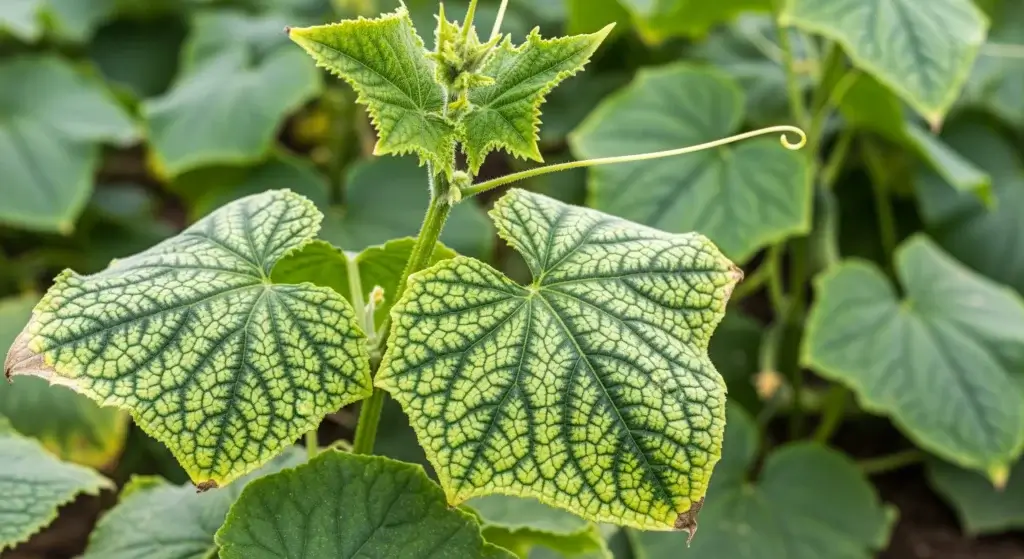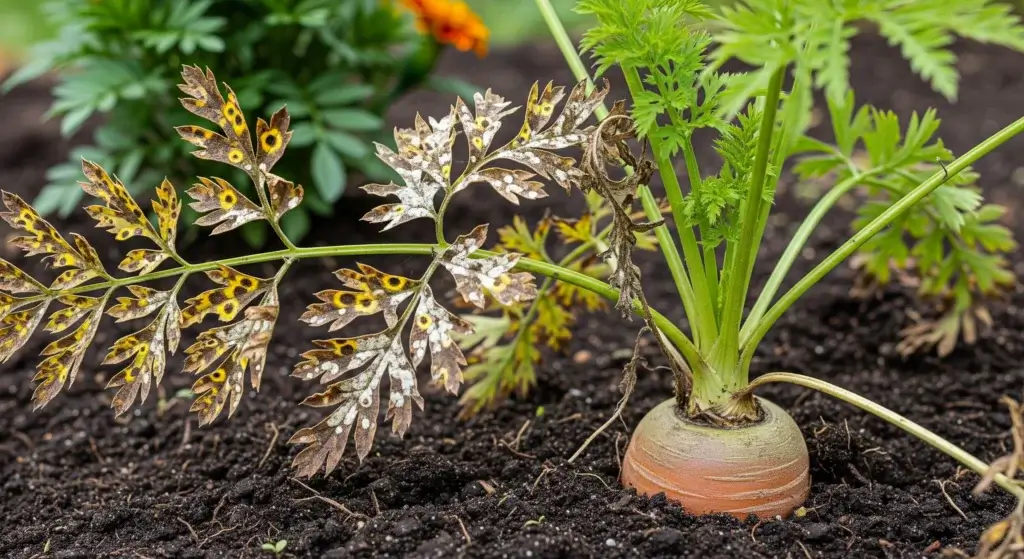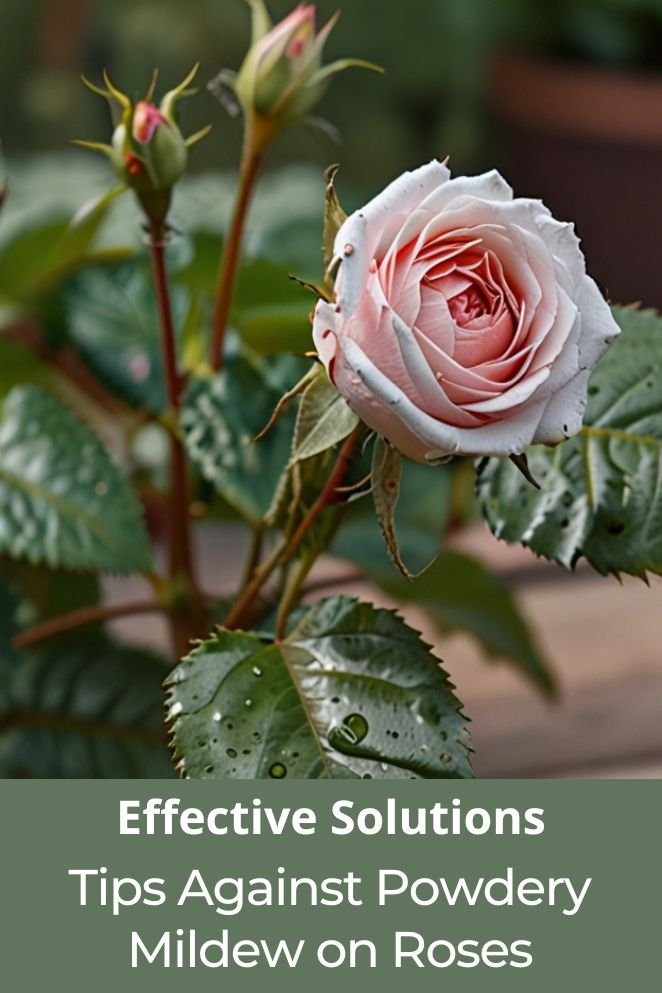
Powdery mildew is a common fungal disease that affects roses, causing white, powdery patches to form on the leaves and stems.
If left untreated, it can lead to significant damage and even kill the plant.
In this article, we’ll explore the signs of powdery mildew on roses, how to differentiate it from other rose problems, and the factors that favor its growth.
We’ll also discuss how to prevent it and provide treatment options, including non-chemical and chemical methods.
Signs of Powdery Mildew on Roses
Powdery mildew is a common fungal disease that affects roses, and recognizing its signs is crucial for effective management.
Here’s a breakdown of the symptoms to look out for:
White, powdery patches
The most recognizable indication of powdery mildew is the appearance of white, powdery patches on the leaves and stems of the rose plant.
These patches can vary in size and intensity, depending on the severity of the infection.
They often start as small spots but can quickly spread across the plant if left untreated.
- Read also: Blooms Without Bugs: Natural Pesticides for Your Roses
- Read also: Tiny Terror: A Guide to Aphid Control on Your Roses
Yellowing or browning leaves
As the disease progresses, the affected leaves may begin to exhibit discoloration, turning yellow or brown.
This change in color indicates that the plant is experiencing stress due to the presence of the fungus.
It’s essential to address powdery mildew promptly to prevent further damage to the foliage and overall health of the rose plant.
Reduced growth
Powdery mildew can impede the growth of the rose plant by interfering with its ability to absorb nutrients and photosynthesize effectively.
As a result, affected plants may exhibit stunted growth or fail to produce new foliage and blooms as expected.
Unpleasant odor
In severe cases of powdery mildew infestation, the affected rose plant may emit an unpleasant, musty odor.
This odor is often indicative of advanced fungal growth and decay within the plant tissues.
While not all cases of powdery mildew result in noticeable odor, it can serve as an additional warning sign of a significant infection that requires immediate attention.
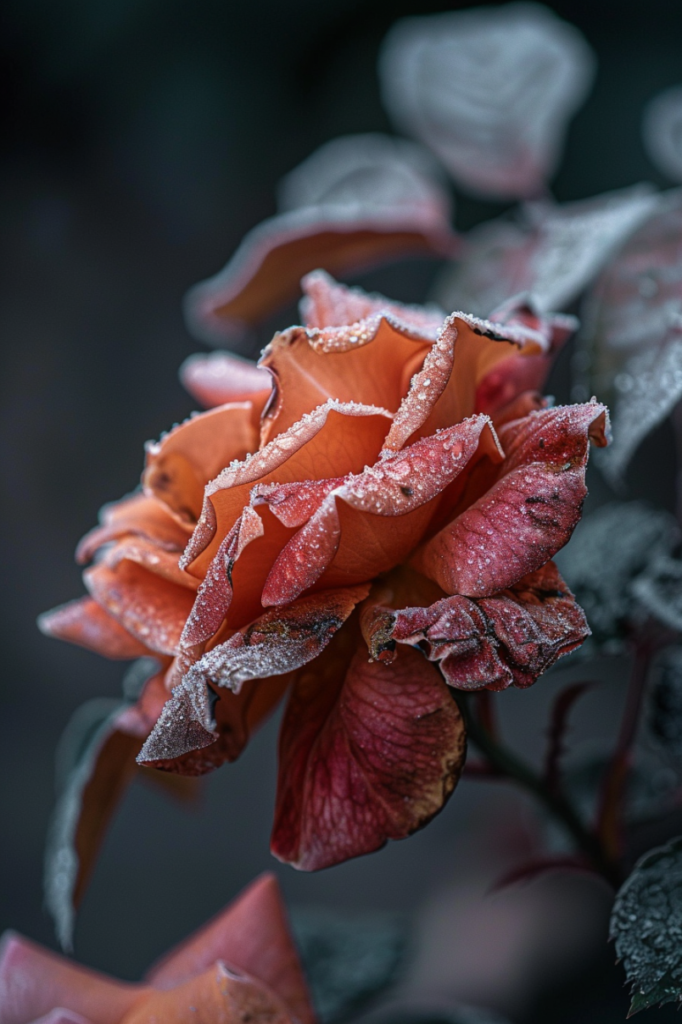
How to Differentiate Powdery Mildew from Other Rose Problems
Identifying powdery mildew amidst other rose issues like aphids, spider mites, or black spot requires keen observation.
Here’s a breakdown of key differences to look for:
Powdery patches
Powdery mildew manifests as distinct white patches on rose leaves and stems, giving them a powdery appearance.
Unlike aphids or spider mites, which may cause leaf damage, they do not produce such powdery patches. Instead, these pests typically leave behind visible bite marks or webbing.
Fungal growth
Powdery mildew is a fungal disease characterized by the presence of fungal hyphae on the plant’s surface.
In contrast, aphids and spider mites are insect pests, causing damage through feeding rather than fungal growth.
While aphids may leave behind honeydew or sticky residue, and spider mites may leave tiny webs, these are distinct from the powdery appearance of mildew.
Systemic infection
Powdery mildew can infect the entire rose plant, affecting leaves, stems, and even roots.
This systemic nature distinguishes it from aphids and spider mites, which primarily target leaves and do not spread throughout the entire plant.
While aphids and spider mites may cause localized damage, they do not pose the same risk of systemic infection as powdery mildew.
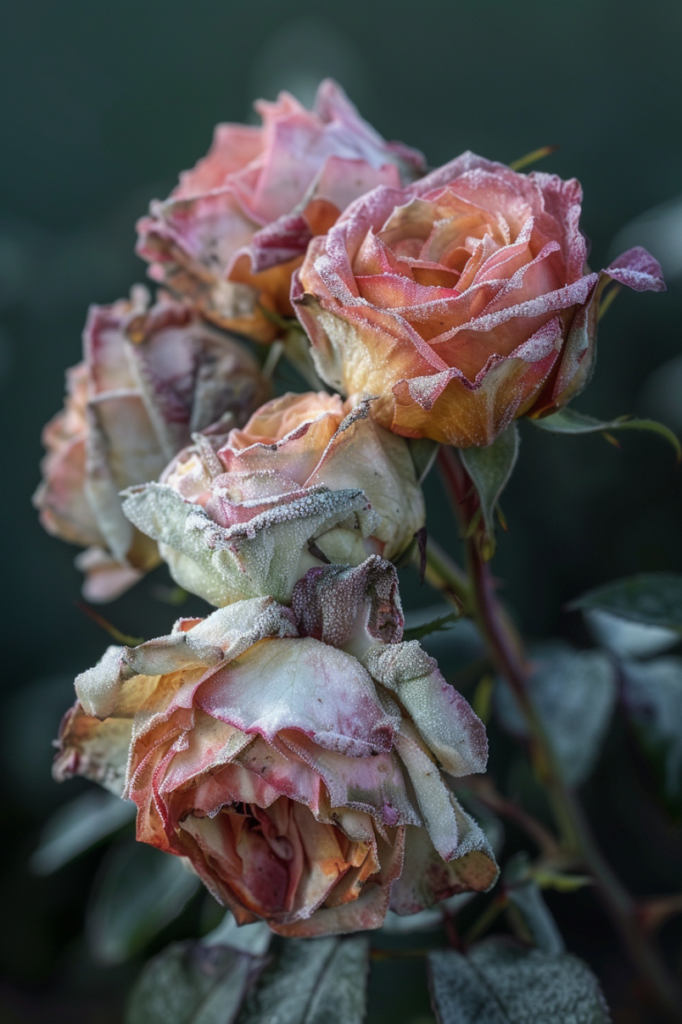
Factors That Favor Powdery Mildew Growth
Several environmental conditions can encourage the growth and spread of powdery mildew on plants.
Here’s a detailed explanation of these contributing factors:
High humidity
Powdery mildew thrives in environments with high humidity levels.
In such conditions, the fungal spores find ample moisture to germinate and spread from one plant to another.
Areas with inadequate ventilation or where plants are densely packed together are particularly prone to retaining humidity, creating an ideal breeding ground for powdery mildew.
Warm temperatures
Warm temperatures, typically above 65°F (18°C), provide optimal conditions for the growth of powdery mildew.
Higher temperatures accelerate the growth and reproduction of the fungus, facilitating its colonization of susceptible plant surfaces.
During warmer seasons or in regions with a tropical or subtropical climate, powdery mildew outbreaks are more likely to occur.
Poor air circulation
Inadequate air circulation exacerbates the spread of powdery mildew by creating stagnant conditions where fungal spores can linger and infect nearby plants.
Areas with dense foliage or where plants are overcrowded are particularly susceptible to poor air circulation.
Without proper ventilation, the risk of powdery mildew transmission increases, as the fungus can easily move from plant to plant.
Overwatering
Overwatering contributes to powdery mildew growth by creating excessively moist conditions that promote fungal development.
While moisture is essential for plant health, excessive watering can saturate the soil and create a humid microclimate around plant foliage.
This excess moisture not only weakens the plant’s defenses against fungal pathogens but also provides an ideal environment for powdery mildew spores to germinate and thrive.

How to Prevent Powdery Mildew on Your Roses
Preventing powdery mildew on your roses is more effective than treating it after it appears.
Here are some practical tips to help you keep your roses healthy and powdery mildew-free:
Improve air circulation
Ensure adequate air circulation around your rose plants by trimming nearby vegetation or strategically placing fans to promote airflow.
Good air circulation reduces the likelihood of powdery mildew spores settling on your roses and helps prevent the fungus from establishing itself.
Water carefully
Avoid overwatering your rose plants, as excess moisture can create a favorable environment for powdery mildew growth.
Instead, water your roses at the base of the plant early in the day, allowing any excess moisture to evaporate quickly.
Consider using drip irrigation or soaker hoses to deliver water directly to the roots and minimize wetting foliage.
Use fungicides
Regularly apply fungicides to your rose plants, especially during periods of high humidity or warm temperatures when powdery mildew is most likely to thrive.
Choose fungicides specifically formulated to target powdery mildew and follow the manufacturer’s instructions for application frequency and dosage.
Organic options are available for those preferring natural alternatives.
Remove infected leaves
Promptly remove any leaves or stems showing signs of powdery mildew infection to prevent the disease from spreading to healthy parts of the plant.
Use sanitized pruning shears to make clean cuts, and dispose of infected plant material in sealed bags to prevent further contamination.
Regularly inspect your roses for early signs of powdery mildew and take immediate action to minimize its impact.

Treatment Options
Discovering powdery mildew on your rose plants can be disheartening, but there are effective treatment options available to address the issue.
Here’s a detailed look at the methods you can use:
Non-chemical methods
Non-chemical approaches offer environmentally friendly ways to combat powdery mildew.
One option is to spray affected plants with water, which helps dislodge and wash away fungal spores from the foliage.
Ensure thorough coverage of all plant surfaces, including the undersides of leaves, and repeat as needed.
Fungicides
Fungicides are chemical treatments specifically formulated to control powdery mildew.
Common options include sulfur-based or copper-based fungicides, which work by inhibiting fungal growth and reducing disease spread.
Follow the manufacturer’s instructions carefully regarding application timing, dosage, and safety precautions.
Apply fungicides when the weather is dry to maximize effectiveness and minimize the risk of plant damage.
Pruning
Pruning infected parts of your rose plants is an essential step in powdery mildew management.
Use sanitized pruning tools to remove any leaves or stems showing signs of infection, such as white powdery patches or yellowing.
Dispose of pruned material in sealed bags to prevent fungal spores from spreading to healthy plants.
Regularly inspect your roses for new signs of infection and continue pruning as necessary to maintain plant health.
Integrated approach
For severe powdery mildew infestations or persistent outbreaks, consider combining multiple treatment methods for a comprehensive approach.
Integrated pest management (IPM) strategies incorporate cultural, mechanical, and chemical control methods to effectively manage plant diseases while minimizing environmental impact.
By combining pruning, fungicide applications, and cultural practices like proper watering and sanitation, you can enhance the effectiveness of your powdery mildew treatment efforts.

- Read also: Sculpting Elegance: A Guide to Desert Rose Plant Pruning
- Read also: Nurturing Beauty: A Guide to Desert Rose Fertilizer Care
Conclusion
Powdery mildew is a common fungal disease that affects roses, causing white, powdery patches to form on the leaves and stems.
It’s a significant problem in rose gardens, especially in areas with high humidity and warm temperatures.
By understanding the signs of powdery mildew, how to differentiate it from other rose problems, and the factors that favor its growth, you can take steps to prevent it.
If you do find that your rose plants are infected with powdery mildew, there are several treatment options available, including non-chemical and chemical methods.

